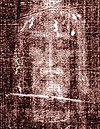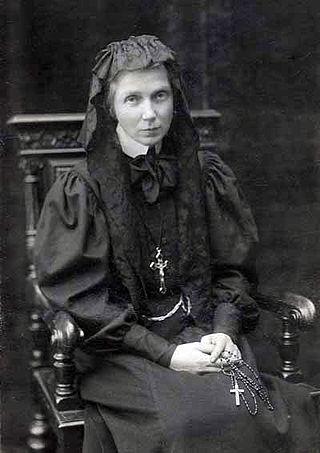
Julia Ledóchowska, USAHJ, religious name Maria Ursula of Jesus, was a Polish Catholic religious sister and the foundress of the Ursulines of the Agonizing Heart of Jesus. Ledóchowska was a prolific supporter of Polish independence which she often spoke about at conferences across Scandinavia while she settled in Russia for a time to open convents until her expulsion. But she continued to found convents across Scandinavian countries and even translated a Finnish catechism for the faithful there while later founding her own order which she would later manage from Rome at the behest of Pope Benedict XV.

Miriam Teresa Demjanovich, SC was an American Ruthenian Greek Catholic Sister of Charity who was beatified by the Catholic Church in 2014. The beatification ceremony was the first to take place in the United States, being held in Newark, New Jersey.
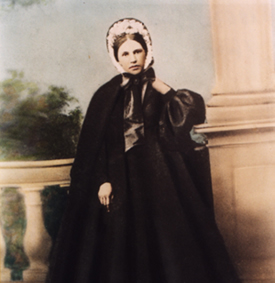
Maria Franciszka Siedliska, also known by her religious name Maria of Jesus the Good Shepherd, was a Polish Roman Catholic professed religious and the founder of the Sisters of the Holy Family of Nazareth. In childhood Siedliska was indifferent to her faith but after a local priest had converted her she became aware of a call to the religious life which her parents opposed. However the death of her father in 1870 enabled her to pursue her vocation. In 1873 she decided to found a religious congregation that received the blessing of Pope Pius IX before being established during Advent in 1875. Siedliska expanded her congregation from Rome to her native Poland and elsewhere, including Great Britain, France and the USA where she visited during her extensive travels.
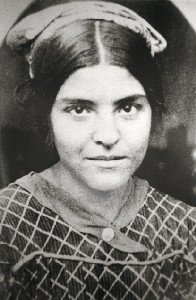
Maria Sagheddu - in religious Maria Gabriella - was an Italian Catholic professed religious and a professed member from the Trappists. Sagheddu had an intense spiritual devotion to ecumenism - something for which she had offered her life - since she desired that all would become one in Jesus Christ. Her childhood saw her noted as stubborn and obstinate though her increased activeness in teaching catechism and joining Azione Cattolica saw those qualities melt and become gentleness and careful attentiveness.

Mary of the Divine Heart, born Maria Droste zu Vischering, was a German noblewoman and religious sister of the Catholic Congregation of Our Lady of Charity of the Good Shepherd. She is best known for having influenced Pope Leo XIII to consecrate the world to the Sacred Heart of Jesus. Pope Leo XIII called the solemn consecration "the greatest act of my pontificate".

Maria Faustyna Kowalska, OLM, also known as Maria Faustyna Kowalska of the Blessed Sacrament, was a Polish Catholic religious sister and mystic. Faustyna, popularly spelled "Faustina", had apparitions of Jesus Christ which inspired the Catholic devotion to the Divine Mercy, therefore she is sometimes called the "secretary" of Divine Mercy.

Giulia Salzano was an Italian Roman Catholic professed religious and the founder of the Catechetical Sisters of the Sacred Heart of Jesus (1905). Salzano served as a teacher prior to becoming a religious and since 1865 worked in Casoria as a teacher for children where she demonstrated herself as an apt catechist and instructor.

Maria Candida of the Eucharist was an Italian Discalced Carmelite. Barba desired to become a nun in her adolescence but her parents forbade this and she was forced to wait two decades to realize her dream; she entered the order after her parents died, though she alienated her brothers in the process. They refused to ever see her due to their resentment of her decision. Barba became a noted member of her convent in Ragusa and she served as prioress. Her devotion to the Eucharist was a focal point for her spiritual thinking and her own life. Pope John Paul II beatified Barba in Saint Peter's Square on 21 March 2004.
Maria Schininà, also known by her religious name Maria of the Sacred Heart of Jesus, was an Italian Roman Catholic nun and the founder of the Sisters of the Sacred Heart of Jesus (1889). Her adolescence demonstrated no particular spiritual emphasis though the death of her father and the marriage of her brother prompted a sudden inner conversion that saw her reach out and collaborate with the ill and the poor; she began in 1885 the foundations for what would become the religious congregation that she set up in 1889.
Blessed Bruna Pellesi, known as Maria Rosa of Jesus, was an Italian nun who was a member of the Franciscan Missionary Sisters of Christ. Pellesi served as an educator in places such as Sassuolo until she contracted tuberculosis and was moved to various sanatoriums for recuperation until the end of her life when she died in her convent.

The Sisters of the Holy Face abbreviated SSV, also known as the Institute of Sisters of the Holy Countenance), are a congregation in the Roman Catholic Church. The congregation was founded in San Fior in Treviso Italy in 1930 by Blessed Maria Pia Mastena.

Blandine Merten, was a German Ursuline. Merten worked as a teacher from 1902 to 1908 in the secular environment while then serving as a teacher while in the religious life from her first vows profession until 1916 when ill health forced her to stop teaching. Pope John Paul II beatified her on 1 November 1987.
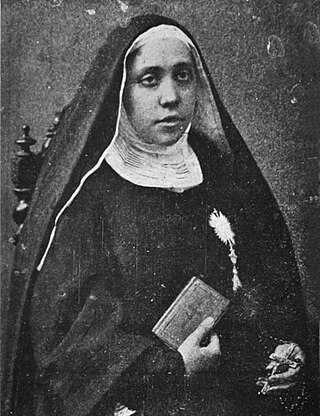
Maria Cristina of the Immaculate Conception Brando, born Adelaida Brando, was an Italian saint, nun and the founder of the Congregation of the Sisters, Expiatory Victims of Jesus in the Blessed Sacrament, an international teaching institute. She was beatified by Pope John Paul II on 27 April 2003, and canonized by Pope Francis on 17 May 2015.

Maria Grazia Tarallo was an Italian Roman Catholic nun. She was a member of the congregation known as the Crucified Sisters Adorers of the Holy Eucharist. Tarallo was given the new name of "Maria of the Passion of Our Lord Jesus Christ" upon the occasion of her solemn profession. She was well known for her charitable nature as well as her strong devotion to the Eucharist.

Blessed Costanza Starace was an Italian Roman Catholic nun. She was the founder of the religious congregation known as the Compassionist Sisters Servants of Mary. Starace later assumed the new name of "Maria Maddalena of the Passion" upon the occasion of her solemn profession. She became a secular member of the Servite Order after she failed to join a religious order.

Leopoldina Naudet was an Italian Roman Catholic of both French and Austrian origins. She was a religious sister of the Congregation of Dilette of Jesus and the foundress of the Sisters of the Holy Family of Verona. Naudet served in the court of Leopold II, Holy Roman Emperor and after his death served his daughter Maria Anna who became an abbess and professed religious alongside Naudet and her sister.
Luigi Boccardo was an Italian Roman Catholic priest and the brother of Giovanni Maria Boccardo. Luigi established the Sisters of Jesus the King as a contemplative branch to his latter brother's Poor Daughters of Saint Cajetan.

Gertrude Prosperi was an Italian Benedictine. Prosperi assumed the religious name Maria Luisa Angelica and finally served as the abbess of her convent for an extended period of time until her death.
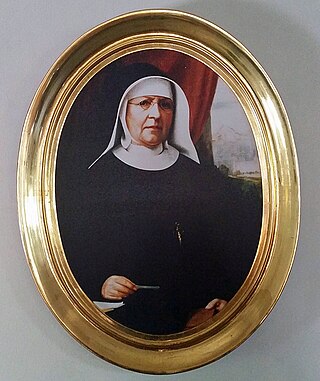
Anna Maria Katherina Scherer was a Swiss religious sister and the co-founder of the Sisters of Mercy of the Holy Cross. She founded that congregation alongside the Capuchin priest Theodosius Florentini. She was given the name Maria Theresia upon her investiture.

Helena Stollenwerk, SSpS was a German Catholic religious sister who collaborated with Arnold Janssen and Hendrina Stenmanns and co-founded the Missionary Sisters Servants of the Holy Spirit.

